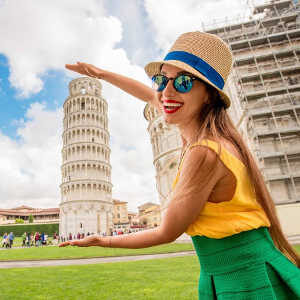Explore the astonishing art collections of two world famous galleries and the fascinating historical centre of Florence, all from the comfort of your own home.
Well known as the birthplace of the Renaissance, Florence is top of the list of cities to visit for any art lover or history fan. This picturesque city along the River Arno is made for exploring on foot as you wind your way through cobblestone alleys to discover incredible architecture and ancient treasures. Join our virtual tour guide for a trip through this remarkable city.
-
Piazzale Michelangelo
We start the tour by taking in one of the top views of the city from Piazzale Michelangelo. This square on the southern side of the Arno River, looks out over the city and is one of the best locations to appreciate Florence’s charm. The square was designed as part of a redevelopment of the whole city in 1869 when Florence was the capital of Italy. On the terrace is a bronze replica of Michelangelo’s famous David, and the building behind was intended to be a museum dedicated to the work of the artist. The museum was never realised, but the building hosts a café and restaurant where you can visit to appreciate the views as you sip on a cappuccino or savour a Tuscan pasta.
-
The Galleria dell’Accademia & David
While best known as the home of Michelangelo’s David, The Galleria dell’Accademia also contains many important works by notable Florentine artists including Sandro Botticelli, Domenico Ghirlandaio and Pontormo. Many of the works were commissioned by the powerful Medici family, and later donated to the gallery for the enjoyment of the general public. While David will surely be top of your list of works to see, there are plenty of other important sculptures and paintings worth discovering. Music enthusiasts will also love the incredible collection of musical instruments in the gallery including rare pieces by Bartolomeo Cristofori, the inventor of the piano, and a 1716 Stradivari violin.
After you have explored the other halls, it’s time to enter the Tribune and meet David. Standing at 5.17 metres high, this astounding marble sculpture by Michelangelo is a masterpiece of the Renaissance period. Sculpted between 1501 and 1504, the statue was originally intended for display on the roofline of the Florence Cathedral but was too heavily to lift roof height. It was displayed in the Piazza della Signoria outside of the Palazzo Vecchio, before being moved to its current home in 1873 to avoid further damage by the elements when cracks appeared in the marble.
Michelangelo was only 26 years old when he won the commission for the work and was tasked with turning the huge block of marble into a monumental sculpture depicting the biblical scene of David versus Goliath. Michelangelo chose to portray the hero not in victory, but before in the moments before the fight, as demonstrated by David’s tense stance and bulgy veins. The twisted body conveys the movement before action, the fight or flight moment before attack. The result is a masterpiece that illustrates the defeat of the giant against the odds, which came to symbolise the fight of the Republic of Florence against the powerful rival states.
-
Piazza Duomo
Leaving the Galleria dell’Accademia, we wander through Florence’s charming cobblestone streets to the Piazza Duomo, where the Santa Maria del Fiore Church towers over the square. The complex including the church with its impressive brick dome, Giotto’s Campanile (bell tower) and the Baptistery, is part of the UNESCO World Heritage Listed historical Florence centre. Construction on the church began in 1296 but was not completed structurally until 1436 with the addition of Brunelleschi’s dome. The dome, designed by goldsmith Filippo Brunelleschi, was built without the use of supporting scaffolding and utilised brick as a lighter material to stop the dome from collapsing under its own weight. It is still the largest brick dome in the world. The exterior is decorated with pink, green and white marble, while sparsely decorated inside with impressive mosaic floors. The most notable artwork is the Last Judgement fresco by Giorgio Vasari. You can climb to the top of Brunelleschi’s dome for spectacular views on the city.
-
Ponte Vecchio
Meandering through Florence’s beautiful alleys and lanes can feel like stepping back to a time of knights and damsels, and nothing feels more medieval than Ponte Vecchio. The bridge crossing at the narrowest of the Arno River is believed to be situated on the site of the original Roman bridge. The current version has been standing since 1345, surviving floods and saved from destruction by the Germans during their retreat in World War II.
It’s not only its age that makes Ponte Vecchio (meaning ‘old bridge’) unique. The bridge is lined with shops for browsing as you cross and a picturesque square in the centre to take in the views along the Arno. The stores initially housed butchers and tanners, but the smell from the waste of these traders was too much for Ferdinand I to bear and he ruled that the shops could only house goldsmiths and jewellers. Above the goldsmiths is a secret passage, the Corridoio Vasariano, constructed for the Medici family to travel between the Uffizi and Palazzo Pitti without having to mix with the commoners.
-
Uffizi Gallery
Our final stop on this Florence virtual tour is the Uffizi Gallery, home to an astonishing collection of sculptures and paintings. The building was constructed by Giorgio Vasari from 1560 – 1580 to house the offices of the Florentine magistrates, with the top floor reserved for the display of artworks. Over the years, more rooms became dedicated to art and now the first and second floors are occupied by the gallery. Many of the works were donated by Anna Maria Luisa, the last heiress of the Medici family. Opening formally as a museum to the public in 1865, it is one of the first modern galleries and is now one of the best know galleries in the world, welcoming 2 million visitors a year.
As Florence is known as the cradle of the Renaissance, it seems only right that the Uffizi Gallery houses one of the best art collections from that period. On display are masterpieces by Raphael, Botticelli, Michelangelo, Caravaggio and more. It would take days to admire all the works on display, but the gallery is probably best known for two works by Sandro Botticelli.
-
Birth of Venus & Primavera
Housed in the same room are two masterpieces by Sandro Botticelli, painted around late 1470 to early 1480. The exact history behind the two pieces is uncertain, though it is thought they were commissioned by a member of the Medici family. Both depict figures from classical Greek mythology, and their large sizes were almost unprecedented in Western art at the time.
Related article: The Best Day Trips from Florence




